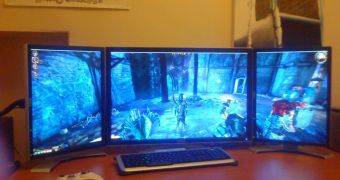For some reason or other, no IT company has made a DisplayPort to DVI Multi-Stream Transport (MST) adapter, and the folks at WSGF want to do something about it.
Wide·screen gam·ing fo·rum is an online community that strives to provide all the game fixes, game support and hardware its members need. This happens to include anything that can lead to a better enjoyment in multi-monitor configurations.
However, WSGF's latest move isn't so much aimed at improving the experience in such situations as it is to allow it.
Seeing that, for some reason or other, no company has made a DisplayPort to DVI Multi-Stream Transport (MST) hub, WSGF contacted a device manufacturer in the hope of having one made.
The hub should remove the need for AMD Eyefinity or NVIDIA Surround technologies by receiving video through one full-size DisplayPort 1.2 input and releasing it via three or four dual-link DVI outputs.
Also, the operating system of a PC would be able to see it as a single large surface without the need for hacks or any specific AMD or NVIDIA GPU.
As if this function alone wasn't enough, the converter would also support Portrait-Landscape-Portrait (PLP), where one large monitor stands in the middle and two smaller monitors (whose length equals the larger one's width) flank it.
Granted, it is possible to set up PLP even with “normal” CrossFire/NVIDIA Surround configurations, or a Matrox adapter, but only through use of the SoftTH software, which isn't particularly user-friendly and is also incompatible with graphics above DirectX 9.
WSGF is still trying to gauge and raise support before commissioning the converter from whatever company it contacted. To that end, it has provided a list of other perks that the converter would possess, not the least of which are Bezel Correction for each monitor, Projector Edge Blending, independent rotation per monitor (hence the PLP support), cropping, image scaling and low latency (just 1 video frame).
Finally, the converter should be DirectX independent, easy to configure and capable of delivering different resolutions to each panel when the screens are mismatched.

 14 DAY TRIAL //
14 DAY TRIAL //